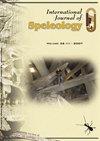Worldwide distribution of cave-dwelling Chelodesmidae (Diplopoda, Polydesmida)
IF 1.3
4区 地球科学
Q3 GEOSCIENCES, MULTIDISCIPLINARY
引用次数: 1
Abstract
Chelodesmidae is one of the most species rich families within the Myriapoda. However, little is known regarding their association with caves. We provide a list of all Chelodesmidae taxa reported from caves, map their worldwide distribution, and discuss the troglomorphic features of the group. A total of 25 species and subspecies from 20 genera and 2 subfamilies have been recorded from 59 caves and cave systems in 11 countries. These numbers represent a surprisingly modest proportion (~3%) of the approximately 800 described species in the family. Records of cave-dwelling chelodesmids appear to be geographically biased with most taxa reported from the Neotropics, likely due to the greater diversity of the group in the region. The lack of published records from the Afrotropics can undoubtedly be attributed to low sampling efforts. In addition, many studies focusing on cave invertebrates, especially in the tropics, often fail to identify chelodesmid taxa to the species level, thus precluding their inclusion on checklists. The majority of the Chelodesmidae reported from caves do not display obvious adaptations to a subterranean lifestyle and are not troglomorphic. The five troglobitic taxa indicated in this study may represent relictual lineages suggesting that few, if any, radiations of chelodesmids within caves have occurred in the past. Increased efforts are needed to bridge the gap between our current understanding and the true diversity of the group in these fragile and threatened habitats, which is necessary to allow policy makers to prioritize appropriate and effective conservation efforts, including the protection of environments severely impacted by human activities.洞穴龟科的全球分布(双足目、多足目)
Chelodesmicidae是Myriapoda中物种最丰富的科之一。然而,人们对它们与洞穴的联系知之甚少。我们提供了一份洞穴中报告的所有Chelodesmicidae分类群的列表,绘制了它们在世界范围内的分布图,并讨论了该类群的穴居特征。在11个国家的59个洞穴和洞穴系统中,共记录了2亚科20属25种和亚种。这些数字代表了该科中约800个已描述物种中令人惊讶的适度比例(约3%)。洞穴螯足类的记录似乎在地理上有偏差,大多数分类群来自新热带地区,这可能是由于该地区该类群的多样性更大。非洲营养不良者缺乏公布的记录无疑可以归因于抽样工作不力。此外,许多专注于洞穴无脊椎动物的研究,特别是在热带地区,往往无法在物种水平上确定螯足类分类群,因此无法将其列入清单。从洞穴中报告的大多数龟科动物对地下生活方式没有明显的适应,也不是穴居动物。这项研究中指出的五个锥虫分类群可能代表了残余谱系,这表明过去很少(如果有的话)发生过洞穴内螯足类的辐射。需要加大努力,弥合我们目前的理解与这些脆弱和受威胁栖息地中该群体的真实多样性之间的差距,这对于政策制定者优先考虑适当和有效的保护工作,包括保护受人类活动严重影响的环境是必要的。
本文章由计算机程序翻译,如有差异,请以英文原文为准。
求助全文
约1分钟内获得全文
求助全文
来源期刊

International Journal of Speleology
地学-地球科学综合
CiteScore
3.10
自引率
23.10%
发文量
12
审稿时长
>12 weeks
期刊介绍:
The International Journal of Speleology has the aim to get cave and karst science known to an increasing number of scientists and scholars. The journal therefore offers the opportunity to all scientists working in and on karst to publish their original research articles or their review papers in an open access, high quality peer reviewed scientific journal at no cost. The journal offers the authors online first, open access, a free PDF of their article, and a wide range of abstracting and indexing services.
 求助内容:
求助内容: 应助结果提醒方式:
应助结果提醒方式:


